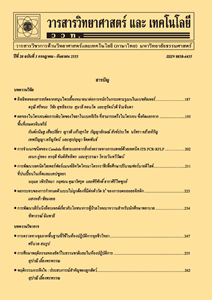การเคลือบฟิล์มบางโปร่งแสงนำไฟฟ้าซิงค์ออกไซด์เจือโบรอน
Main Article Content
Abstract
บทคัดย่อ
การเคลือบฟิล์มบางซิงค์ออกไซด์เจือโบรอน(ZnO:B) ลงบนแผ่นกระจกเพื่อใช้เป็นขั้วโปร่งแสงนำไฟฟ้าได้ทำการทดลองเตรียมด้วยกรรมวิธี Metal Organic Chemical Vapor Deposition (MOCVD) โดยใช้สารตั้งต้น ไดเอททิลซิงค์ (Diethylzinc, DEZ) กับ น้ำ (H2O) และใช้ก๊าซไดโบเรน (B2H6) เป็นสารเจือ ภายใต้สภาวะสุญญากาศ ในการทดลองได้ศึกษาผลกระทบของอุณหภูมิและอัตราการไหลของก๊าซสารเจือต่อสมบัติทางไฟฟ้า คุณสมบัติทางแสง และโครงสร้างผลึกของฟิล์ม ZnO:B โดยทำการทดลองที่อุณหภูมิ 100oC, 150oC, 180oC และ 200oC ผลการทดลองพบว่าเมื่ออุณหภูมิสูงขึ้น ความต้านทานไฟฟ้าและเปอร์เซ็นต์การส่องผ่านแสงมีค่าลดลง การวิเคราะห์โครงสร้างผลึกจากภาพถ่ายด้วยเครื่อง SEM ที่อุณหภูมิ 180oC กับ 200oC เกิดผลึกรูปทรงพีระมิด เมื่อวิเคราะห์ด้วยเครื่อง XRD ความเข้มของสเปกตรัมแสดงระนาบ (100) อย่างชัดเจน โดยที่อุณหภูมิ 180oC มีความเข้มสเปกตรัมของระนาบ (100) มากกว่าที่อุณหภูมิ 200oC ต่อจากนั้นเลือกอุณหภูมิที่ 180oC ศึกษาผลของการเติมสารเจือ B2H6ที่ 0 sccm., 5 sccm., 10 sccm., 15 sccm., และ 20 sccm. ผลการทดลองพบว่าเมื่อเพิ่มปริมาณการเติมสารเจือมากขึ้น ทำให้ค่าความต้านทานไฟฟ้าลดลง และเปอร์เซ็นต์การส่องผ่านแสงเพิ่มขึ้น จากภาพถ่ายด้วยเครื่อง SEM พบว่าการเพิ่มปริมาณสารเจือ B2H6ทำให้ขนาดของเกรนเล็กลง พิจารณาความเข้มสเปกตรัมด้วยเครื่อง XRD พบว่าการเติมสารเจือ B2H6 ที่ปริมาณ 10 sccm. แสดงระนาบ (100) อย่างชัดเจน
คำสำคัญ : ฟิล์มบางโปร่งแสงนำไฟฟ้า; ซิงค์ออกไซด์; สารเจือโบรอน; เซลล์แสงอาทิตย์
Abstract
The boron doped zinc oxide (ZnO:B) transparent conducting thin film coating on a glass plate was experimentally prepared by Metal Organic Chemical Vapor Deposition (MOCVD) method. Diethyl zinc (DEZ) and water (H2O) were used as reactants, and diborane (B2H6) was used as doping gas in a vacuum system. The effects of temperature and flow rate of diborane gas on electrical and optical properties and crystal structure of the ZnO:B thin film were studied. The experiments were carried out at temperatures of 100oC, 150oC, 180oC and 200oC. The results showed that while the temperature was increased, the electrical resistance and the transmittance decreased. From the surface observation by scanning electron microscope (SEM), pyramid-shape crystals were found at temperatures of 180oC and 200oC. By using x-ray diffraction, the spectrum of (100) plane was shown clearly at the experiment temperature of 180oC, and it was higher than that of 200oC. The temperature of 180oC was selected, and then the effect of B2H6 doping gas on properties was studied by varying the flow rate at 0 sccm, 5 sccm, 10 sccm, 15 sccm and 20 sccm. The experimental results showed that with increasing the flow rate, the electrical resistance decreases and the transmittance increases. The SEM micrographs showed that the higher flow rate the smaller grain sizes. The XRD spectrum revealed clearly the (100) plane at the B2H6 flow rate of 10 sccm.
Keywords: transparent conducting thin film; zinc oxide; boron doping; solar cell


